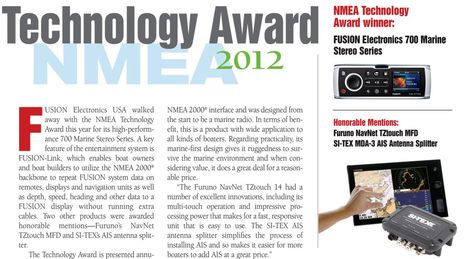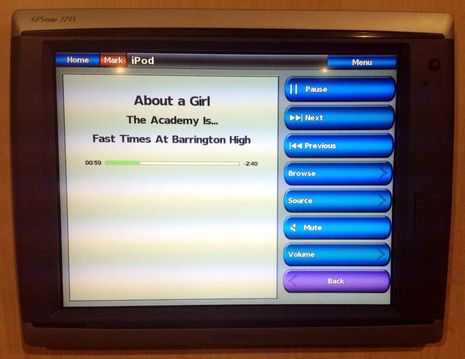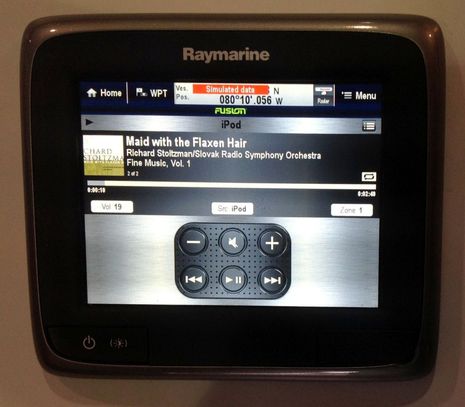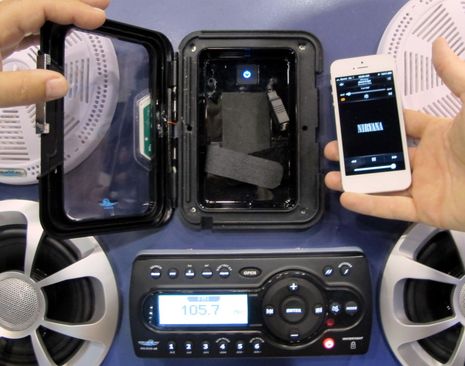Fusion 700 Series update, mission accomplished?
I’ve been testing (and enjoying) a Fusion MS-IP700 and MS-NRX200 system since I installed them in June and I wholeheartedly support the 700 Series as NMEA’s Technology Award winner of the year. And note that I wasn’t a judge myself this year and unfortunately wasn’t even there (especially as I’ve heard repeatedly that the 2012 NMEA Conference was the success hoped for). You can read all about it in this online version of the ME Journal, and further note that the judges didn’t see the cool multi-manufacturer Fusion MFD interfaces that debuted in Fort Lauderdale…
First up is Garmin’s MS-700 interface, which is done over NMEA 2000 and will soon be available in a software update for all Garmin 4000 and higher networked MFDs. I got a quick tour and didn’t see any Fusion 700 controls missing, and that’s saying a lot. Multi-zone volumes, playlist browsing, etc. are all there. Besides the menu system seen below, there’s also a small control bar that fits under navigation windows, plus I was told that iTunes videos work fine if you run an RCA cable between the video ports on the Garmin and the MS-IP700 (plus DVD video if you have an MS-AV700 and iThing dock)…
But then again Raymarine previewed its version of FusionLink which runs over Ethernet and therefore can include all of the above plus cover art, and in fact somewhat mimics the Fusion WiFi remote control app. This software update will work on the a-, c-, and e-Series (but not the C- or E-Wide Series or earlier, I’m pretty sure), though it won’t arrive until Lighthouse 6. However, Lighthouse 6 is coming sooner than you might think, and the 5 version that debuted in Lauderdale is loaded with goodies I’ll soon write about.
And those of you with fairly current Lowrance, Simrad, or Furuno gear shouldn’t feel left out just yet; I’ve only heard rumors, but they’re good ones. Fusion seems to have pulled off quite a coup, adding both N2K and Ethernet to what was already an innovative marine AV system and then getting several of — maybe all of! — the major MFD companies to add yet more value to the systems. Definitely NMEA award worthy, don’t you think?
However, I know at least one Panbot who passed over Fusion for his new boat because he wanted the Bluetooth streaming available in a Clarion CZ501, which is also a feature coming to a new version of the clever AquaticAV Media Locker I saw at last year’s IBEX. Is there any end to all the I/O a marine AV system can have? In fact, Fusion says they’ll be adding Bluetooth eventually, though they’re a bit concerned about the EMI on some boats. I believe that they will also get rid of their annoying proprietary NMEA 2000 connector in future models, and that they’ve got more feature ideas in the works. Right now, though, Fusion has every right to crow.

















I have the 700 being put into a 44 cat that I have being built. It is by far the best I could find but here are the shorts. Would be great if it had an hdmi in and out. Would like 5.1 as well. I have the unit if the salon and the hard wired remote at the helm. I have twin furuno tz14 touches at the helm. I would love to see furuno build to the fusion SDK but was told about this at miami and no sign of it in version 2. I also have set up my system so an apple tv can put content on one on the tz touches.
I think that the Fusion 700 definitely is deserving of an award but do you think it is not a little hypocritical of NMEA. Should they not pull their finger out and assign std PNG’s rather than everybody going their own merry way with proprietary PNGs – this is holding up boat integration.
Seems to me that Garmin picked the better options in connecting via NMEA2000. I have the fFusion 700 and a couple remotes connected via NMEA 2000 and they work fine–although the updates can be a bit slow.
The problem with ethernet is that I am assuming that will mean the Fusion 700 has to be connected to RayNet. (aka SeaTalk hs.) I already have the Fusion 700 hooked to my router so I can use the cool iPad/iPhone apps that fusion has for the 700. So I have the new e-series and the Fusion 700, but Raymarine’s version of integration is a non-starter. (Sometimes I wonder in system designers ever check with customers to see how there equipment is actually being used.)
The best bet would to connect using WiFi. But that would mean that Raymarine would have to allow their MFDs to connect to the boat’s AP. As Ben recently noted, Furuno allows this, but Raymarine stubbornly refuses to do.
Stuart, I can tell you that many members of NMEA are frustrated by the slow pace of PGN creation. But the few people actually responsible for making them happen, primarily Technical Director Steve Spitzer, will tell you that the process is naturally slow because it’s dependent on the work of industry volunteers and also because it’s coordinated with international standards-making organizations.
But I don’t see what this has to do with the Fusion award. For one thing, NMEA did not choose Fusion; three of my colleagues in Boating Writers International did the judging, based on criteria of innovation, practicality, and benefit/value to boaters. You can learn a lot about the Award in the ME Journal: http://goo.gl/cJLDK
I don’t really know the details of how FusionLink works behind the scenes, but it seems likely that Fusion created a library of proprietary N2K messages and a way to put them on Ethernet which they non-exclusively license to MFD manufacturers. I know they wanted a say in how the finished MFD interfaces look and work. And I doubt they’d share their work with another stereo manufacturer 😉 But then again no other stereo manufacturer has demonstrated the slightest interest in developing interfaces like this, so who would have gotten together on a committee to develop standard PGNs?
Finally, try not to think of NMEA as an organization that thinks as one. It simply doesn’t, as I tried to explain in August: http://goo.gl/T4rWm
I bet even with Raymarine, it connects via their N2K system, then, it can communicate via their seatalk HS or Raynet devices. Remember, Raymarine can manipulate all N2K devices WITHOUT having ALL of their MFD’s connected to a N2K network.—it communicates with all MFD’s on their Raynet/SeatalkHS network.
So, its actually better than Garmin. IF you want the device to be controlled by more than one station, you would have to have more N2K cables going to all the MFD’s, in addition to their Network cables. So it saves money and is easier to install.
I think you’re wrong, anon, because N2K does not have the bandwidth to carry cover art. I’m pretty sure that Raymarine is interfacing to the Fusion 700 via Ethernet.
I guess in some situations there’s value to distributing N2K data to MFDs via Ethernet, like Ray MFDs can do, but I prefer having N2K to each MFD. That’s how I have the e7 and e127 on Gizmo now, and it means that either one can be system master, depending how I’m using the helms. It also means that either one will work as a plotter and instrument display even if the RayNet goes down. It may be noteworthy that Furuno went from insisting on N2K over Ethernet with NavNet3D to insisting on N2K to every TZT MFD.
Seadog, there is the potential for virtually unlimited PGN’s possible, and it’s hard to imagine what the user’s and manufacturers might want, and then create standard PGN’s for these potential scenarios. Just a couple of years ago Wifi, and Bluetooth didn’t exist on MFD’s and now the are wireless apps coming out the wazoo. I can only guess, but Fusion wanted the integration capability, wrote the PGN’s and had them certified by NMEA. Maybe this is a type of model to come. A manufacturer creates a PGN, and has it certified. If there is an apparent demand for the application, then a standardized set of PGN’s could be created for everyone else to use. In my case, I thought Fusion’s use of N2K in this case was novel, and new.
Thanks, Bill, but let me clarify. While the Fusion 700 Series AV head and NRX remote control are NMEA 2000 certified, N2K certification as I understand it is more about good behavior over the network than specific PGNs.
Proprietary PGNs are allowed and standardized ones are not certified but instead created by NMEA subcommittees. I believe that is common for companies to offer their proprietary PGNs to NMEA for standardization, but that may not be the case with Fusion.
Thanks for pointing that out Ben, I stated it poorly. What I was referring to was the NMEA standard PGN database they maintain, and sell. It is the defacto standard, and by implication all are required to understand and use them. The NMEA certification specifically refers to the the network communication hardware architecture and implementation.
A reader of an earlier Fusion 700 thread — http://goo.gl/oyil9 — asked about Apple’s new Lightning connector and it’s worth noting on this entry. The Lightning is definitely a problem for consumers with existing iPod/iPhone/iPad accessories and for the folks that develop those accessories.
Fusion has a particularly tough problem as their iPod/iPhone docks are tightly designed to the old 30 pin connector. It’s hard to imagine how an adapter can be fit into existing models, but maybe a new model could be designed to accommodate either connector. I do know that Fusion is working on it, but I think they just started because apparently Apple surprised their accessory developers with the Lightning.
Fusion advertises that the 700 series has a built in VHF receiver. Can that be configured to take priority over music playback when it receives a VHF hail?
Campbell,
The MS-IP700 has a modal audio receiver –AM/FM/VHF. Just like any old radio: once you are in a mode, you are in that mode. The VHF mode does have squelch, which is nice.
No functionality is offered for automatic switchover to or fro anything else, at least not in the software version that came with the brand new device installed on my boat last week.
I don’t think it was ever realistic to think one would stick one’s iPhone in the dry vault provided inside the MS-IP700. First, there is no provision for telephone use, other than car-industry standard “mute” contact, to connect an external handsfree system such as a Parrot. Second, are you really not going to check your WhatsApps, iMessages and emails? Third, iPhones are there for the apps and having yours locked inside the stereo means no app use for the duration. So we stuck an old iPhone 4 in there, loaded with no apps, no SIM card, and 32GB of good tunes, and called it a day. My advice: put a 160GB iPod classic inside.
We downloaded the $10 Fusion-Link iPhone/iPad app and it is surprisingly good. Rock-solid stable, user friendly, and provides rich iPod functionality (menus) for the iPod device inside the MS-IP700 –nearly as if you had the locked iPod in your hand. The app actually works better on the iPhone than on the iPad because the functionality is more self-evident on the small screen than in the unnecessarily ornate iPad screen real estate.